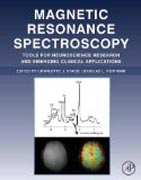
Magnetic Resonance Spectroscopy: Tools for Neuroscience Research and Emerging Clinical Applications
Stagg, Charlotte
Rothman, Douglas L.
Magnetic Resonance Spectroscopy covers how MRS is acquired, what it can measure, application to common research and clinical questions, and the advantages and limitations of the technique. Chapters are authored by experts in each topic area, and the book is written with a non-expert audience in mind. Magnetic resonance spectroscopy (MRS) is a noninvasive imaging technique that allows quantification of many neurochemicals. MRS is used in clinical neuroscience as a method for investigating brain neurochemistry, critical to understanding neurological and psychiatric disease. Improved acquisition and analysis approaches have increased interest in its use for traditional clinical applications and neuroscience research; this book meets the growing need of neuroscientists, neurologists, psychiatrists, and radiologists for reliable information on the technique. The only cutting-edge reference on this powerful brain imaging technique geared specifically to neuroscientistsEnables neuroscience researchers and clinicians who are not experts in this technique to incorporate it into their research and practiceIncludes application to psychiatry, neurology, radiology and basic neuroscienceEdited work with chapters authored by leaders in the field around the globe - the broadest, most expert coverage available INDICE: Section 1: Technical Aspects - How MRS Is Acquired 1.1 Basis of Magnetic Resonance 1.2 Single Voxel Approaches and Water Suppression, Novel Approaches Including Ultra-short TE 1.3 Technical considerations for Multi-Voxel Approaches / MRSI 1.4 Spectral Editing and 2D NMR 1.5 Spectral Quantification & Pitfalls in Interpreting MRS Data - What to Look Out For Section 2: Biochemistry - What Underlies the Signal? 2.1 N-Acetylaspartate and N-Acetylaspartylglutamate in CNS Health and Disease 2.2 The biochemistry of major metabolites - Creatine 2.3 The biochemistry of major metabolites - Choline 2.4 Glutamate 2.5 Other significant metabolites: MyoInositol, GABA, Glutamine & Lactate 2.5 Other Metabolites: MyoInositol, Glutamine, Lactate, Glycine Section 3: Applications of 1H-MRS 3.1 Usefulness of Proton Magnetic Resonance Spectroscopy in the Clinical Management of Brain Tumors 3.2 Multiple Sclerosis and Inflammatory Diseases 3.3 Epilepsy 3.4 Stroke and Cerebral Ischaemia 3.5 Use of MRS in Inborn Errors of Metabolism. Canavan's Disease. MRS in Differential Diagnosis 3.6 MRS of Psychiatric Disorders 3.7 Pre-Clinical and Clinical Applications of 1H-MRS in the Spinal Cord 3.8 Inter-individual Differences in Behaviour and Plasticity 3.9 MRS in Development and Across the Lifespan 3.10 Hormonal Influences on MRS Measures 3.11 MRS in Neuroenergetics and Neurotransmission Section 4: Applications of Non-proton MRS 4.1 Quantitative Metabolic MR Imaging of Sodium, Oxygen, Phosphorus and Potassium in the Human Brain: A Rationale for Bioscales in Clinical Applications 4.2 Carbon [13C MRS] 4.3 Hyperpolarized MR Imaging and Spectroscopy of the Brain
- ISBN: 978-0-12-401688-0
- Editorial: Academic Press
- Encuadernacion: Cartoné
- Páginas: 398
- Fecha Publicación: 16/01/2014
- Nº Volúmenes: 1
- Idioma: Inglés
